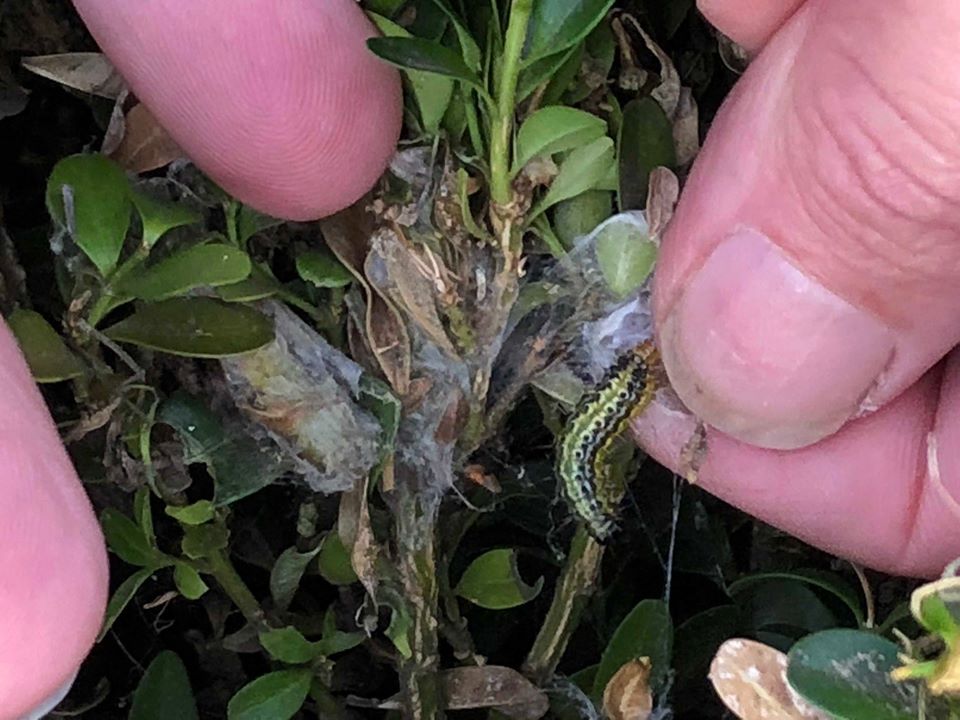What We Know About Box Tree Moth
While recent reports of a new (to North America) insect pest of boxwood in the Toronto area have not yet been confirmed by the Canadian Food Inspection Agency (CFIA) or USDA APHIS, many in the nursery and landscape industries are rightfully concerned and asking questions.
In case you missed it, a homeowner reported seeing an unusual moth on her neighbor’s boxwood hedge in Ontario, Canada in late August and snapped a picture of it. An entomologist later identified it as box tree moth, a newer pest spread throughout the EU. Since then, two other homeowners in Ontario found samples as well and reported their observations to a citizen science-based website, iNaturalist.com. Again, neither CFIA or APHIS has confirmed that this is indeed box tree moth, Cydalima perspectali. Hopefully it is a case of mistaken identity, but if not, our industry needs to be informed and prepared in the event it makes its way the US.
This pest is considered a strong flyer, capable of flying about 6 miles (or 10km) per year, but most spread is attributed to movement of infested plant material. Eggs present on leaf undersides can easily go undetected. Box tree moth was first confirmed in the EU in 2006/2007 in Germany and the Netherlands. From there, it has spread throughout the EU, defoliating gardens and natural box woodlands. Fortunately, research in the EU gives us a heads up on some of the specifics of this pest.
Box Tree Moth Damage. Photo Copyright Bennett Saunders. All rights reserved.
Its lifecycle takes about 45 days, depending on temperature. As many as 3-4 generations per season are possible in Central and southern Europe, from mid-late March through October. It overwinters in its pupal state on leaves and can survive temperatures as low as -22 F (-30 C) in winter, meaning it can survive most winters in the contiguous US. Pheromone traps can help monitor adult male populations from May to October.
Box Tree Moth Larvae. (Photo Copyright Bennett Saunders. All Rights Reserved.)
Host plants include all Buxus species. In its native East Asia, Euonymus and Ilex are reported hosts as well, but this has not been observed in the EU. Damage to boxwoods is caused by caterpillars, or larvae, as they eat leaves and bark. If the damage is contained only to defoliation, most boxwoods will recover. However, death can occur when the caterpillars consume bark. Effects of box tree moth are often compounded by boxwood blight infections.
Symptoms include quick defoliation of boxwoods, webbing present on leaves and stems, and presence of caterpillars.
Several insecticides have been evaluated, with successful caterpillar control reported with chlorantraniliprole, spinosad, and chlorpyrifos + cypermethrin. Success has also been reported using Bacillus thuringensis strains. In the event this pest is confirmed in the US, other products that typically express good efficacy against Lepidopterans should be considered, such as abamectin, acephate and pyrethroids. Always check labels for use information.
If you see a suspicious-looking moth or caterpillar, please consult your local extension service or diagnostician. Production and landscape managers in the Great Lakes regions should be especially diligent in monitoring boxwoods, as the adults could easily fly from Toronto to upper Michigan, if positively confirmed in the Toronto area.
Dr. Jill Calabro
Director of Science & Research, HRI + AmericanHort
Share This Post








